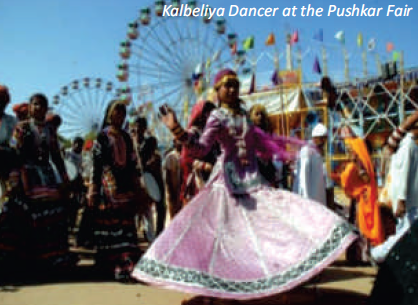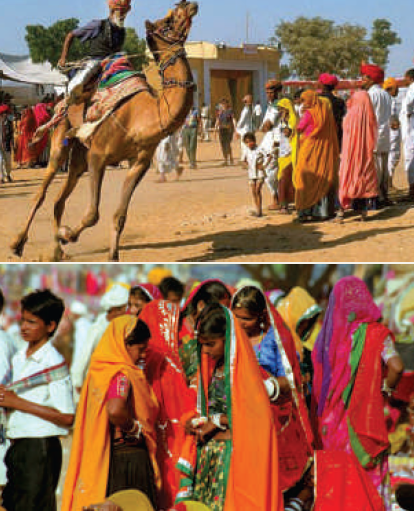Pushkar
This is a collection of articles archived for the excellence of their content. Readers will be able to edit existing articles and post new articles directly |
This article has been extracted from THE IMPERIAL GAZETTEER OF INDIA , 1908. OXFORD, AT THE CLARENDON PRESS. |
Note: National, provincial and district boundaries have changed considerably since 1908. Typically, old states, ‘divisions’ and districts have been broken into smaller units, and many tahsils upgraded to districts. Some units have since been renamed. Therefore, this article is being posted mainly for its historical value.
Contents |
Pushkar
Town, lake, and place of pilgrimage in Ajmer District, Rajputana, situated in 26 29' N and 74 33' E ; 2,389 feet above sea-level. Population (1901), 3,831, neaily all Hindus, Pushkar is said commonly (but erroneously) to be the only town in India that contains a temple dedicated to Brahma, who here performed the sacri- fice known as yaj net, \\hereby the lake of Pushkar became so holy that the greatest sinner, by bathing in it, earns the delights of Paradise. The town contains five principal temples, dedicated to Brahma, Savitri, Badn Narayan, Varha, and Siva Atmateswara ; but they are of modern construction, as the earlier buildings suffered severely under Aurangzeb, Bathing ghats line the lake, and many of the princely families of Raj- putana have houses round the margin, No living thing may be put to death within the limits of the town, A great fair is held in October and November, attended by about 100,000 pilgrims, who bathe in the sacred lake. At this time there is a large tiade in horses, camels, bullocks, and miscellaneous merchandise.
Pushkar
By Geeta Nandakumar
India Harmony VOLUME - 1 : ISSUE - 3 APRIL, 2012
Enchanting Pushkar
More than 400 temples in a small Indian town by a beautiful semi- circular lake with 52 lovely ghats is a surprise. And Pushkar is just that, an enchanting smorgasbord of religion and culture that intoxicates and holds tourists in thrall. The byzantine lanes of its bazaars are choc-a-bloc with people soaking in and unravelling the aeons' old culture of a timeless land. While tourists throng the town round the year, the influx rises to massive levels, when devotees and tourists descend there in pilgrimage to one of the most sacred sites of the Hindus in the month of November, when the town also hosts an exotic extravaganza – the world's largest camel and cattle fair.
Tirtha raj
The sparkling Pushkar lake is situated on the edge of the desert surrounded by hills on three sides and separated from Ajmer by the 'Nag pahar' . The mountain houses the ancient cave of saint Agastya and the poet Kalidasa. So taken in was the poet by the sylvan surroundings, that he made it the setting for his masterpiece 'Abhigyana Shankuntalam'. Legend has it that Ajmer and Pushkar are hoary, they date back to the time when Lord Brahma was in search of a tranquil land to perform a 'yagna', a fire ritual. A lotus (pushp) fell from the hand (kar) of the Lord into the valley and the lake that sprang up at the spot was named Pushkar by the lord Himself. A temple dedicated to Lord Brahma in Pushkar is a hugely popular place of pilgrimage and is replete with lores about Lord Brahma.
Pushkar is regarded as the tirtha raj, or, the
holiest of sacred places among the five
'dhams' that are a must visit for Hindu
pilgrims. Pushkar has the only temple in the
world for Lord Brahma (the Creator of the
Universe), one among the holy Trinity – the
other two being Lord Vishnu, the Preserver
and Lord Shiva, the Destroyer.
Since the cycle of creation, preservation and destruction is an ongoing process in the Universe, the three Gods represent a whole. If the morning dies to give birth to noon and the noon dies to give way for the night, creation and destruction (birth and death) are inherent and twin sides of the same coin and preservation or maintenance of the day before nightfall is also part of the process. Hence, the Trinity is manifest at all times. While, there are temples aplenty dedicated to Lord Shiva and Lord Vishnu in India, Pushkar boasts of the only temple dedicated to Lord Brahma.
Lord Brahma as the Creator of the Universe,is the first among these equals or the Divine Triad. An individual's subtle body is constituted of his mind and intellect, that is, his entire thoughts. Man's subtle body is responsible for the creation of his gross body and also the world that he experiences. This phenomenon is true not only of the microcosm but of the macrocosm as well. The cosmic subtle body is the aggregate of all subtle bodies of living beings. The cosmic subtle called the Hiranyagarbha, is said to be the creator of the entire universe. This creator is Brahma. The four-faced Brahma statue in Pushkar has four hands, symbolises the four Vedas. The mystic symbolism is also about the functioning of the inner personality comprising the thought process, the mind (manas), the intellect (buddhi), ego (ahamkara) and conditional consciousness (chitta). In Hindu iconocgraphy, Lord Brahma is generally seen in austere attire dressed in animal pelt holding the four Vedas or the Book of Knowledge in one hand; a kamandal in another; a sceptre in the third that represents destruction of ego and renounciation in order to dedicate oneself for the welfare of the world, as well as rosary beads in the fourth hand that indicate meditation as the path of final realisation of God, all symbolic of the pathway to be adopted by a seeker desirous of attaining the ultimate spiritual state, through spiritual discipline. Brahma, the Creator of the Universe as well as the intellect and the subtle mind has Saraswati, the Goddess of Knowledge as his consort and the Swan as his official vehicle, as it symbolises Grace and discernment. The gateway to the temple in Pushkar is adorned by a 'Hans' or Swan and the walls of the temple adorned with pictures of peacocks, the official vehicle of Goddess Saraswati.
While legend has it that Goddess Saraswati, also known as Savitri had cursed Brahma for performing a yagna in Her absence, with Gayatri as his consort, the subtle reason for the few Brahma temples is the fact that the Creator of the Universe, who has already performed the job of creation is less worshipped and it is the path of the Destroyer (Lord Shiva) and the preserver of existence (Lord Vishnu) that most humans seek since they are in the process of destroying their negative thought processes to attain Godhood. For the intellectuals, seeking creative ways to improve the world around, Lord Brahma is of immense importance!
For seven days in the month of Kartik (the eighth Lunar month) in October- November, tens of thousands of devotees throng this small temple town to pay homage to Lord Brahma and to seek enlightenment and salvation. Hindu pilgrims come for the holy dip in the Pushkar Lake, with the maximum gathering on Kartik Poornima (the full-moon day of the month of Kartik). The belief is that a dip in the Pushkar Lake on this auspicious occasion brings salvation to devotees. In the autumn night, thousands of oil lamps are floated in the lake as a mark of worship of Lord Brahma. The entire atmosphere is aglow with the illumination of the lamps and the deep faith of the devotees.
Carnival time
The seven-day Pushkar festival is marked by a trade and cultural extravaganza for the first five days. As is typical of everything Indian, the spiritual and the temporal meet seamlessly. For, even as the tourists throng the town on the edge of the magnificent lake, ostensibly, for a communion with the Divine, they are part of the huge local mela that is the Pushkar fair. And since it is Rajasthan, the local folks make the all -purpose and ubiquitous camel that is at the heart of all life in the state, the focal point of the fair. The spiritual centre takes on a cultural and business hue as brisk trade in camels and cattle is done. And alongside, the business, there are camel races and beauty pageants for the dromedary too! After the first five days which are a time of camel and carnival, before the focus shifts to the religious festival of Kartik Purnima. In this tale of the ethnospiritual fest, the peaceful pilgrim town explodes into a spectacle of local culture, layered and intertwined with myth, history and spirituality resulting in a bewildering bazaar of gypsies, gods and dromedaries.
Pushkar's exquisite bazaars hawk everything from miniature paintings, embroidered beads, colourful bangles, leather goods or lovely brass utensils to tattoo shops. Pushkar has something for everyone. For those in love with traditional items such as mesmerising puppets and pottery, Pushkar is considered to be one of the most interesting places to shop. A giant hot airballoon safari over the holy city of Pushkar gives tourists a kaleidoscopic view of the scenic beauty of Pushkar Lake and the ancient treasures which this city offers.
The Cattle and Camel Fair at Pushkar is the
largest one of its kind on the planet. Over
50,000 camels find their way to the Pushkar
Fair to be traded off or to display their best
features, beauty and tricks. The fair brings
unique competitions that are very funny and
very entertaining. At the beauty contest for
example, camels vie with each other adorned
with painted motifs and wearing beautifully
embroidered and mirror-worked saddlecloth.
Camel race and camel dance being the other
highlights of the fair. Men are not less
interesting here with giant-sized mustaches
and beards in unique shapes and designs.
Turban-tying, henna and bridal competitions, folk dances, acrobatic performances, and puppet performances lure over 2,00,000 visitors. The spectacular fair grounds are filled with beautifully decorated camels and cattle, adventurous competitions and events. Meditating sadhus, holy dip in Pushkar lake, huge number of stalls, folk dances and colourfully dressed people from all over the world are a feature of the fair. Over the years, this mela has become one of the major cultural reflectors of Rajasthan and people from different parts of the world gather to participate in the events.
There are snake charmers – whose hypnotic music entices cobras to rise out of wicker baskets and dance, elaborately dressed street performers, ash-covered Sadhus lost in a spiritual trance – and six-legged cows, whose owners highlight their deformities to elicit money from the curious. There are fortunetellers, healers, jugglers, dancers and storytellers. And of course, there are tribal women in their brightly coloured saris and lehengas with the thousands of arresting faces that reflect the long and fascinating history of an ancient culture that continues to live in the heart and soul of Rajasthan. Thus, a fascinating blend of Sufi Culture, hindu spirituality and the magnificent colours of Rajasthan make the twin towns an irresistible draw.







